Iberian pioneers of Submersibles
The submarine has many fathers. Among the pioneering nations, Spain has been at the forefront of early submarine development.
Narcis Monturiol was the inventor of no less than the first fully functional engine-driven submarine. The Ictineo I and II however appeared at a time the Armada was still clinging to its old privileges and maintained a traditional fleet of mixed vessels, hoping to keep a wide Empire afloat.
In the 1880s, this situation has worsened amidst economic difficulties aggravated by the loss of the South American Empire after the Bolivarian revolutions. Meanwhile, Spanish engineer and sailor Isaac Peral created in 1888, sixteen days before another pioneering electric submarine, the French Gymnote. It was at the same time the first fully capable military submarine, and first electric battery-powered submarine. A formula which will stayed very much alive for much of the next Century.
Development of Spanish Submarines
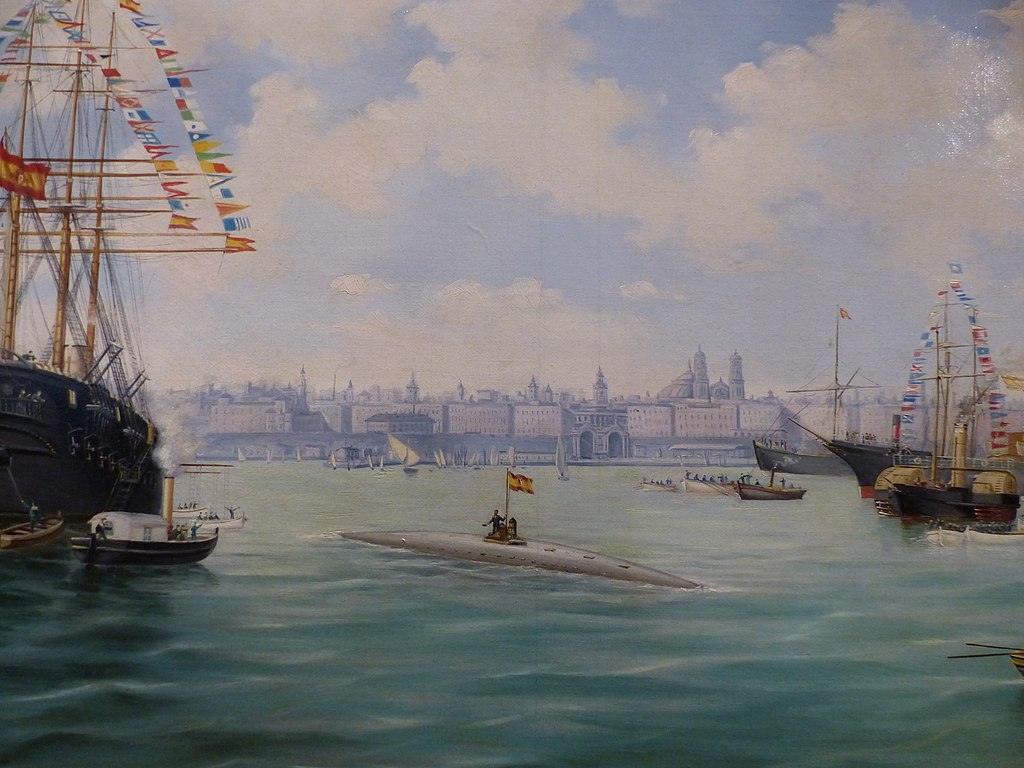
The Peral (1888) tested in Cadiz. Unfortunately the model was never adopted by the Navy and was not present during the war of 1898. Its presence could have curbed events during the war, if posted in Cuba or Manila.
These dreams were shattered however in 1898, with the crushing defeat in the hands of the US Navy, but despite of this, nothing was capitalized on this unique skill. When the Armada staff decided to return and give a try to the submarine again, it was already war. Although neutral, the idea of submarines as modern, effective yet still untested coastal defence vessels seems seductive. However the 1880s Peral has been discarded in 1909 and nothing has been attempted since.
Therefore, the naval staff decided to procure submarine through the naval law of 15 February 1915 prospected to find soon the active Holland Company, though the Royal Navy reference (which was its first submersible active type). After the 1916 Fore River Yard Isaac Peral, the admiralty turned to Fiat-San Giorgio and their promising Laurenti double-hull type to deliver two submarines. This became the “A” type, followed by a licence from Holland for more submarines, built at Cartagena DYd, started under the same nav law of 1915 in July 1916. However construction dragged on, to the point the six “B” class were only launched in 1921-23 and completed afterwards. Next was the “C” class, by the same yard and under the same Holland (Electric Boat Company) licence, enlarged and improved, launched 1927-29.
When the civil war broke out in 1936, the Republicans possessed 13 submersibles of various ages and conditions. Their fate was quite diverse, but most served with the Republicans: Sunk, scuttled, or captured. For their next model, the D-class, the Republican government strangely turned to Germany. The first two were laid down in 1933 and 1934 but none was completed in time. Their incomplete, fitting out hull was laid to rest for the whole civil war and WW2 as well, although they were launched in 1944 and completed at the end of the war. The third was barely started so she was completed in 1954, the last worldwide German U-boat of this generation to enter service !
About Narcís Monturiol
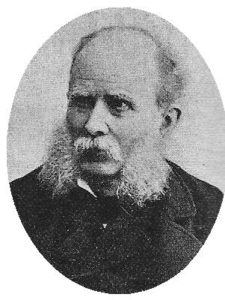 The father of Spanish Submarines could be considered on par with T. Fulton, D. De Lôme or John Holland closer to us; This was XIXth Century Vernian Technology at its best. Better than that, it worked at a time most warships were still sailing man-o-war and Frigates.
The father of Spanish Submarines could be considered on par with T. Fulton, D. De Lôme or John Holland closer to us; This was XIXth Century Vernian Technology at its best. Better than that, it worked at a time most warships were still sailing man-o-war and Frigates.
Monturiol i Estarriol was born in the city of Figueres, the son of a Cooper, he became an editor in 1846, a feminist and utopian communist. Soon he joined the Republican party and departed for France, exiled for a time, returning after the 1848 revolution and later changed occupation for Science instead of politics as the new government censored him. Finding in Cadaques the dangerous job of coral harvesters a cause to work on, he started to work on an underwater device. This went so far as founding in 1857 the first commercial society in Spain dedicated to the exploration of submarine navigation (Monturiol, Font, Altadill y Cia). The next year he presented to the press and investors his scientific thesis ‘The Ictineo’ or fish-ship. In 1859, he built it as Ictineo I, presented to the public in Barcelona in September. At that time most navies were just transitioning to steam and the French Ironclad ‘Gloire’ was just completed.
After the Ictineo I made fifty dives before disappearing because of an accident in 1862, he created La Navegación Submarina to raise funds to built the larger Ictineo II. The latter first sortied on 20 May 1865 and made a dive to 30 meters. It was not using human propulsion but used a chemical mixture generating both heat and oxygen to power a simple engine. It was to be coupled with a classic steam engine to sail on the surface. Just like the first it was made in wood.
The submersible made a new sortie with its new powerplant but eventually on 23 December 1862 his company went bankrupt. Afterwards, Monturiol returned to politics. He would be the first to create a successful anaerobic propulsion system. Only in 1940 the Germans would start again on this principle to improve their classic U-Boats and they would only partially succeed with the Walter turbine, which stayed largely experimental until nuclear propulsion was adopted, nearly a century after Ictineo II…
Another inventor: Cosme García Sáez
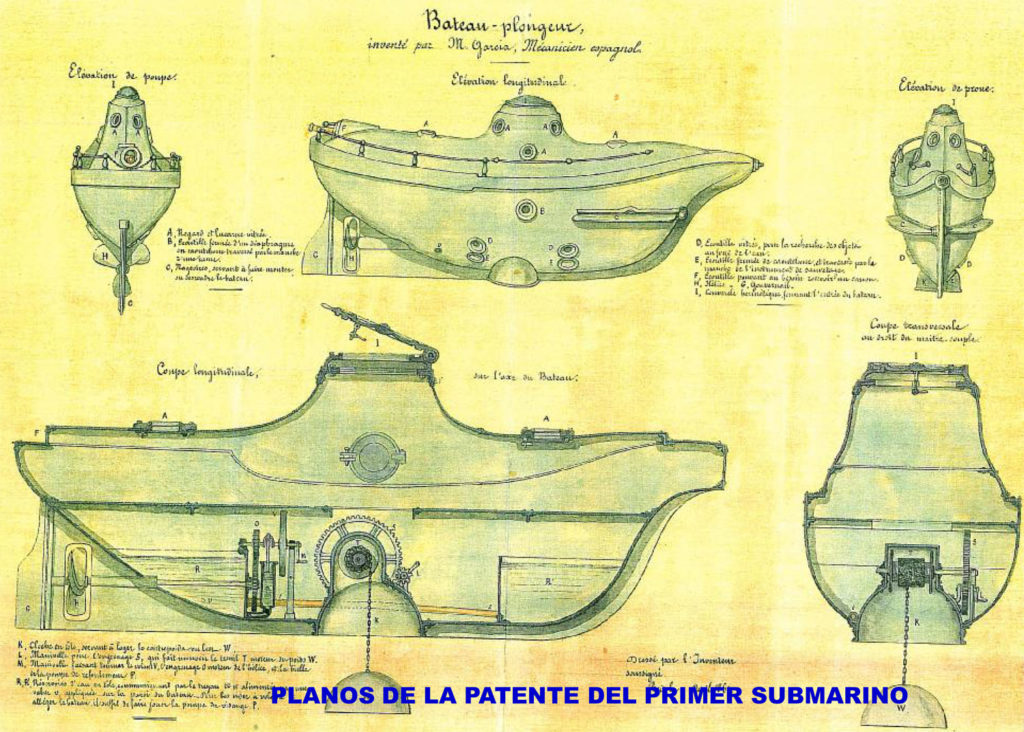
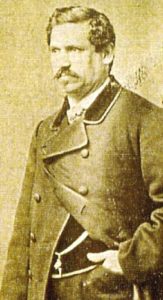 Saez was born 1818 in Logroño, and became a Spanish inventor, claiming he was first to invent a submersible, preceding Monturiol and Peral. Self-taught without formal training in engineering, he carried out tests for years and patented a submarine in Spain and in 1860. The submarine was built and successfully carried out official tests in Alicante. The submarine could accomodate just two. On November 16, 1860, another patent was granted in Paris under the name of “Bateau Plongeur” (lit. “diver boat”). Built in Barcelona the boat was transferred to Alicante and tested on August 4, 1860 crewed by the inventor and his son, with successes. Cosme García afterwards had high hopes to built a new model entirely made in copper and went to Madrid to present a model to Queen Isabel II at the palace. The queen showed her admiration but warned Garcia that no finance could be expected as Spain was already head and toe plunged into the costly African war. Cosme García then traveled to Paris and met Napoleon III’s technicians. They invited him to move to Toulon and build one, but Garcia eventually rejected the offer.
Saez was born 1818 in Logroño, and became a Spanish inventor, claiming he was first to invent a submersible, preceding Monturiol and Peral. Self-taught without formal training in engineering, he carried out tests for years and patented a submarine in Spain and in 1860. The submarine was built and successfully carried out official tests in Alicante. The submarine could accomodate just two. On November 16, 1860, another patent was granted in Paris under the name of “Bateau Plongeur” (lit. “diver boat”). Built in Barcelona the boat was transferred to Alicante and tested on August 4, 1860 crewed by the inventor and his son, with successes. Cosme García afterwards had high hopes to built a new model entirely made in copper and went to Madrid to present a model to Queen Isabel II at the palace. The queen showed her admiration but warned Garcia that no finance could be expected as Spain was already head and toe plunged into the costly African war. Cosme García then traveled to Paris and met Napoleon III’s technicians. They invited him to move to Toulon and build one, but Garcia eventually rejected the offer.
Anchored in Alicante, the submarine was evacuated as the port authority estimated it was an hinderance to the marine traffic. His son Enrique García eventually scuttled the ship by opening the valves and it sunk to the bottom where he still remains. His son later tried to offer the submarine again to the Spanish government on the occasion of the Spanish-American War, in vain. In 1993 a committee reevaluated the inventor’s legacy, an institute in Logroño was named after him, and in 2026 a new S-80 Plus type submarine is planned to be named after him.
Ictíneo I (1858)
This very early submarine served from 28 June 1859 to January 1862, financed by public subscription after the idea came 12 years prior. It was made in wood and at the origin was created to allow coral divers to work in safety. The name derived from the Greek ikhtys (fish) and naus (boat). It displaced 10 t (9.8 long tons; 11 short tons), was 7 m (23 ft 0 in) long for the outer hull, and 4 m (13 ft 1 in) for the pressure hull, 1 m (3 ft 3 in) wide for the pressure hull, height and was 2.5 m (8 ft 2 in) high for the outer hull. It was human-propelled unfortunately, Hand crank, could stay underwater for two hours and on paper dive to 50 m. In reality when making her first test in Barcelona harbour she hit some underwater pilings, and Montutiol estimated it would cost too much to repair her and instead she was “patched” for the first dive, limited to 20 m. Ictineo I was slow, but Monturiol estimated he could improve her underwater autonomy by developing a compressed oxygen system coupled with a carbon dioxide scrubber. They were never mounted because of the lack of funds, but Ictineo I made some 50 dives, but destroyed when a Cargo rammed her by accident.
Ictíneo II (1864)
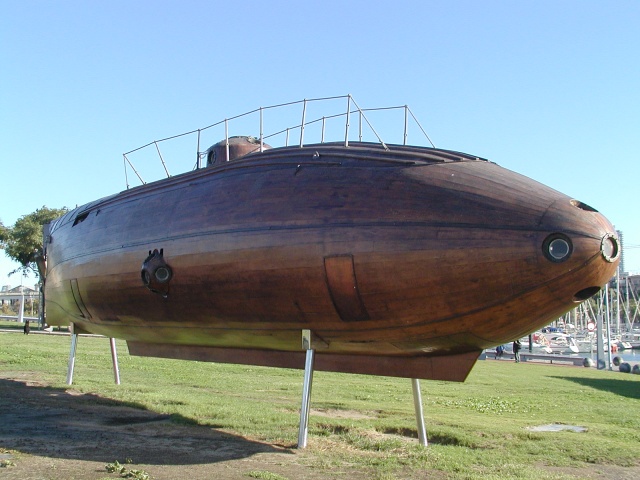
Ictineo II
This second vessel, also in wood, was created through the company La Navegación Submarina, financed by the people of Catalonia. Technically she was way above the Ictineo I in many respects: Larger, she displaced 46 t (45 long tons; 51 short tons), was 14 m (45 ft 11 in) long for the external hull by 2 m (6 ft 7 in) and 3 m (9 ft 10 in) high. The hull was made in wood again, despite the will of a metalic submarine, much larger as initially planned. It was made of olive wood with oak reinforcements, covered with a 2 mm thick layer of copper. Visiblity was good, thanks to three glazed portholes 20 cm (7.9 in) in diameter, with 10 cm (3.9 in) thick glass. Manoeuvers were made from a conning tower, through an endless screw gear mated to the propeller shaft. She made dives thanks to four ballast tanks of 8 cubic metres (280 cu ft).
But the real genius of the design back in 1862 was she had an air independent steam engine submerged, coupled to a coal-powered steam engine for the surface. The closed-loop engine used a chemical reaction of zinc, manganese dioxide and potassium chlorate. This heated the boiler of a steam engine. This also helped lighting the ship. Same steal engine, two boilers, one for the surface and one underwater. Top speed was 4.5 knots surfaced, and endurance submerged reached 7 hours with a test depth of 30 m (98 ft). Monturiol was satisfied with the design, which was in practice the first combined propulsion submarine. Dupuy de Lôme’s inspired Plongeur released in 1865 had a closed-loop system using compressed air, but autonomy was reduced.
Isaac Peral (1888)

Isaac Peral was an officer with an intense career in the Spanish Navy. After intervening in the Ten Years War in Cuba, Third Carlist War where he was decorated he also worked on a “practical theoretical treatise on hurricanes”, the the survey of the Simanalés canal in the Philippines and in 1883 he took over the chair of Physics-Mathematics of the extended Studies school of the Navy.
After the Carolinas crisis in 1885, he tried to convinced the admiralty that he definitively solved the challenge of underwater navigation. Assisted by the best scientists of the School the project was passed onto the Minister of the Navy, Manuel de la Pezuela, which became enthusiastic about it. Unfortunately, the next ministers showed his indifference, Beránger and Rodríguez Arias buried the folder.
However through the Regent queen María Cristina, the submarine project was reopened, and a prototype built in 1888. The boat was successfully tested but the authorities rejected the invention and even attacked the inventor, which eventually was forced to leave his post in the Navy and called for the public opinion but died due to skin cancer in 1895.
The Peral’s hull was made of steel, spindle-shaped with three trim tanks, with an ingenious valves system. Maximum immersion level was 30 m. The submarine used two electrically driven horizontal axis propellers for manoeuvrability, and had a forward-throwing tube seen also on the North American Holland type. Laid down in harrow on January 1, 1888 the Peral was launched in September, 8 in San Fernando. Tests were carried out on December 25, 1888, with a commission headed by Florencio Montojo Trillo (navy dept. head), and frigate captain Joaquin Bustamante and Quevedo.
The commission imposed Speed tests, Surface navigation and evolutions, Dynamic immersion, with speed tests, torpedo launching tests on the surface and in immersion and tactical sea trials.
The Peral was the first submersible sing electric propulsion, in the Spanish Navy and abroad. As tested in February 15, 1890 by Isaac Peral, range was estimated to 66 hours, or 284 nautical miles (511 km). However daytime attacks failed against the Cruiser Christoforo Columbo and other units, detected at 1000 m. This was aggravated by the estimation by the commission that its autonomy was unsufficient, despite the fact the prototype met Peral’s own specifications.
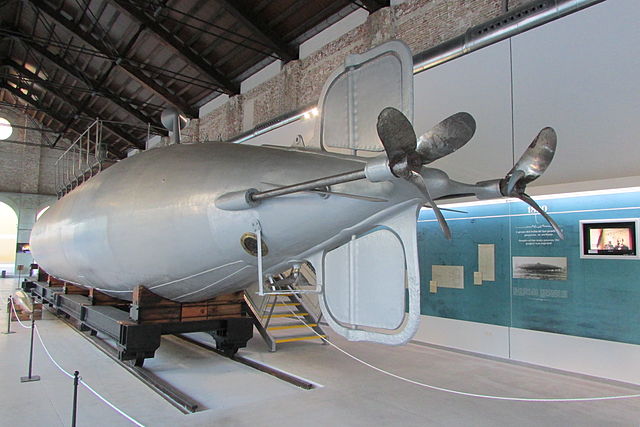
First serial submarines: WW1
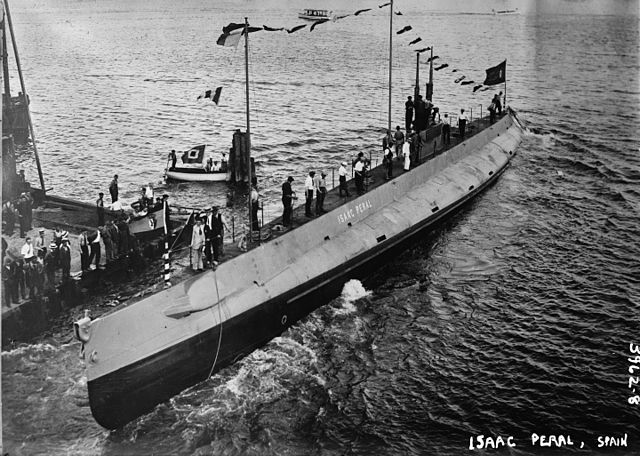
At the beginning of the First World War, the Italian company Fiat-San Giorgio product of the merger with Officine Meccaniche FIAT di Torino of the S. Giorgio shipyards owned by A. Odero, completed the project of a coastal submarine derived from the previous one class Medusa class. In this way, the class F (Laurenti type) was born. The last three of the serie were purchased and served until the 1930s, scrapped because they became obsolete and worn-out. They spent long time inactive due to engines problems but constituted the Spanish A class.
Interwar submarines development
Reflexion about the place and role of submarine in the Armada evolved to reach the same level as in other navies, but with limited funds. Soon, it became imperative to gain the know-how to create submarines in Spain, in particular through the Cartagena Yard which had the required manpower and skills, plus material reserves. Indeed the wartime classes has been built in the USA (Holland design) and Itali (Fiat-Laurenti design), allowing to test the most popular design trends of the day. That was a solid basis for further developments.
The Interwar saw three classes, B, C and D with relatively large and homogeneous series of six boats each. It seems the admiralty first tried the very popular Holland type with the A type (A0 was the US-Built Isaac Peral), while A1-A3 were WW1 era Italian-built boats which gave good (counter-) examples for inspiration and served until 1931-34. The B-class submarines were the first Spanish-built submarines. All made by Cartagena Dyd, they were launched in 1922-27. Their general design was clearly based on the Holland A0-type, with some specifics. The C-class however were improved Holland type but not revolutionary. By that time the design was already obsolescent as surface speed and agility and more TTs were preferred over underwater prowesses. This trend was already readable in th C-type design, which had 533 mm tubes instead of the weaker 450 mm, more torpedoes, and a lessed underwater speed but better diving depth.
The D-type, planned in the 1930s was curiously ordered before the Republicans were in power in 1926, by the Carlists which laned towards Germany. The German design was indeed judged more modern. Howeve the Republicans did not cancelled the order placed to Cartagena once licence was acquired and the D-class were laid down in 1933 and 1934. They were well advanced in 1936 but apparently still not launched, and construction stopped entirely for the duration of the civil war, and only resumed during WW2, both D1 and D2 being launched in 1944. D3 was laid down much later and completed during the early cold war, the last commissionned classic interwar U-boat worldwide…
Spanish submarines during the civil war
The Republican submarines
When the civil war broke out in July 1936, the Republicans possessed all the submarines of the fleet in service, the twelve B and C classes. The Laurenti type A class has been already retired and scrapped. Of the six B class, two were sank in action, B5 by aviation off Malaga and B6 by the nationalist destroyer velasco and other vessels off Cabo Penas. B1-B4 were all scuttled at Cartagena in April 1939 to avoid capture. Only B2 was repaired, only to serve as a floating generator plant during WW2.
The improved C-class also served with the Republicans, with weaker efficiency since some officers were removed from command by fear of Nationalist allegiance. It was less obvious on smaller ships and submarines, but technicity and maintenance somewhat fell to lower standards, traduced by less active sorties at sea. Completed in 1930, the vessels were fresh and modern though, and made good accounts for themselves. C1 was sunk on 9.10.1938 by aviation, C3 was torpedoed by an Italian submarine off Malaga in December 1936, C5 was lost in the Bay of Biscay from an unknown cause, C6 was scuttled at Gijon in October 1937 to avoid capture, C2 and C4 survived and served with the Francist Navy during WW2. Both in fact were being overhauled in France from 1937 and surrendered at the end of the war.
During the Civil War also Republican submarines were used to carry and deliver post between the Iberian Peninsula and the island of Menorca (see the sources). This was a 1938 attempt after the failed attack of the Ebro, to hold the ground and finance the war effort by any meanse necessary. This included issuing a unique and exclusive stamp series, in the shape of propaganda posters made by famous artists in adverstising. 25,000 stamps were made by the Oliva de Vilanova printing works in Barcelona and delivered by classic ways to Barcelona and Maó (Menorca). The latter however fell isolated after the breakowns of all communications and was only supplied by submarine C-4.
Nationalist submarines
The Nationalists attempted to conceal the acquisition of two Italian Archimede-class submarines, (General Mola class), renamed conveniently C-3 and C-5, so claiming the original one has been raised and recommissioned. Modern history tends to consider the kill was likely the result of a torpedoing by precisely such Nationalist-held, ex-Italian submarine, although Conways only states it was “an italian submarine”.
On the Nationalist side indeed, six submarines ended in active service, all Italian-built. These were the two General Mola class boats (ex-Torricelli and Archimedes) – See later. They were both still active during WW2 and the cold war as well, stricken only in 1959, also the last examples of interwar Italian submarines in service. Four more Italian submarines were also provided during the civil war to Franco: Ferraris, Galilei, Iride and Onice. The first were oceanic types of the same class as General Mola (the excellent Archimede class) The last two were renamed Gonnzales Lopez and Aguilar Tablada, showing the Spanish Nationalist flag, but they remained fully under Italian control, with Italian crews and supervision. All four only served for a short time in Spanish waters and were transferred back to Italy.
U-Boats in the civil war: Operation Ursula
The (in)famous Legion Condor deployed notably the pocket ‘battleship’ Deutschland, but also two U-Boats in Spanish waters, U 33 and U 34. Their engagement as kept secret until the Berlin parade of 06 June 1939 in which participated veterans of the Legion Condor including crews of both submarines.
This forgotten chapter of the German Naval History became thus public, but has been surrounded by many myths. This was the first “hot” deployment of Kriegsmarine U-boats. Only a few authors covered this chapter with whatever available documentation over the years, therefore differences with regard the events, and participants emerged. The secret involved including in the case of U-33 and U-34, a strict confidentiality under all circumstances, warranted by death penalty was applied on the crews. Most of these eye witnessed have died in the meantime, either in WW2 or in the cold war.

U-33 at sea in 1937
The mission started in early 1939, led by an either a pocket battleship or a light cruiser as flagship, composed smaller warships for a deployment lasting for 4 to 5 weeks. The 4th Task Force deployed in November-December 1939 was for example led by the Admiral Scheer. In the meantime and before the war ended in June, U-Boats were initially planned to deployed as early as 02 November 1936, but the project was passed onto Rear Admiral Hermann Boehme which set it to August 1936. The secret deployment of both U-boats was officially a training mission under the codename Operation Ursula. The rules of engagement were clear. The captains were authorized to attack at will any spotted “red” Republican vessels, either warships or civilian. The Type VII A U-33/34 were chosen and made U-Flotilla “Saltzwedel”, shortly after commissioning in September 1936.
Radio camouflage included codenames such as Triton and Poseidon during the trip. Both U-Boats were under command respectively of Ottoheinrich Junker and Harald Grosse. They departed Wilhelmshaven during the night 20 to 21 November 1936 and sneaked into the Gibraltar strait. After arrival they were deployed from Alicante and Cartagena respectively. In december apparently, both submarines fired their first torpedoes but missed. They claimed later a unknown Republican destroyer. They also missed another destroyer and the cruiser Méndez Núñez. Deployment went on in 1937 despite the London Submarine Agreement signed also by Germany on 28 November 1936.
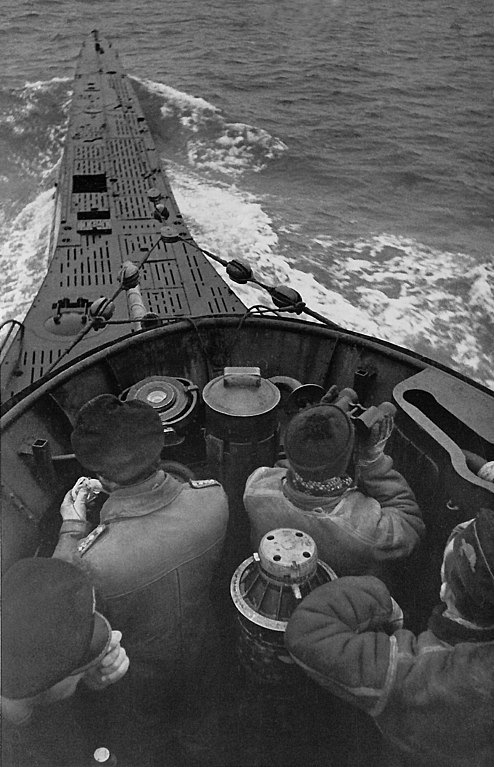
Kiosk view of the U-33, date unknown.
However it was agreed Axis submarines would be authorized to patrol the Mediterranean Coast of Spain (Almeria-Valencia for the Kriegsmarine). In the autumn of 1937, sorties focused on west off Gibraltar and in the Bay of Biscay. More U-boats were apparently deployed this year and the next ones, starting with U-25, twelve in all which was consequent given the limited capabilities of the kriegsmarine at that time. Encounters of Republican vessels (and Basque ships) were rare and in any case no attack was allowed, but the experience gained by these officers was later passed onto successes in the early phase of U-boat dpeployments during WW2 associated with names such as Günter Prien, Wolfgang Lüth, Otto Kretschmer, Gerhard Schreiber, Victor Oehrn, Fritz Frauenheim or Werner Hartmann.
https://www.youtube.com/watch?v=Lj1vy7Xy3oA
Video about the Submarine C3
WW2 Franco’s submarines
With the crippling losses of the civil war, Franco’s Navy, the Armada Espanola, only represented 1/3 of the original Republican helf Navy. Submarines were lost in action or scuttled and never repaired. In all, Franco could only count on the C-class boats, as B-class ones that could be retreived were scrapped in 1939, to the exception of B2 converted as a generator plant to reload batteries of other submarines, and survived WW2.
Of the C-class boats only two remains: C2, discarded in 1952, and C4, lost in June 1946. They were retreived from a French yard while in refit which ended with the civil war. They were among the oldest Holland-type designs afloat at that time.
However Franco has a possible ace in his sleeve into the shape of the D-class submarines. These boats planned in 1926, ordered in 1933 and laid down this year and the next, were certainly svereal fold better than the previous Holland types. A leap forward in capabilities. However construction dragged on to the point they missed completely the civil war, and construction was sonly resumed by 1942-44, when they were launched, but not completed until 1947 and 1951 respectively while D3 was laid down in 1945 and not completed until 1954. Therefore they all missed WW2 but served extensively until the adoption by the Cold War Armada of GUPPY boats under MDAP. Amazingly, so scarce were resources in postwar Spain that these unsuccessful boats served until the late 1960s and 1971 while the G7 was last of the classic German U-boats in active service anywhere else in the world…
But these were not the only axis submarines in service with the Armada when the war broke out in 1939: In addition to the two C-types, the Armada could count on the two General Mola class submarines, and the single ex-German U-boat named G-7. She was the type VIIC U-573, interned at Cartagena after being badly damaged by British aviation in 1943. She was purchased by the Spanish government and pressed into service as G-7. She saw service during WW2 and the cold war, discarded only in 2.5.1970.
Read More/Src
http://peppoweb.com/submarinoc3/
Submarine C3 (Spanish) web archive
clashofarms.com: Naval_Aspects_Spanish_Civil_War (pdf)
en.wikipedia.org/wiki/Spanish_submarine_C-3
Operation Ursula Documentary
es.wikipedia.org/wiki/Submarino_Isaac_Peral_(A-0)
es.wikipedia.org/wiki/Submarinos_Clase_F_(Tipo_Laurenti)
//forum.axishistory.com/viewtopic.php?t=29518
//www.kbismarck.com/mgl/spanishcivwar.htm
//uboat.net/articles/59.html
//ajuntament.barcelona.cat/gabinetpostal/correu-submari/?lang=en
//dubm.de/en/the-spanish-civil-war/
//www.amazon.com/Spanish-Civil-War-Sea/dp/B00AW92JSA
//www.armada.mde.es/ArmadaPortal/page/Portal/ArmadaEspannola/buquessubmarinos/prefLang-en/01s70
A class submarines of WW1 (1917)
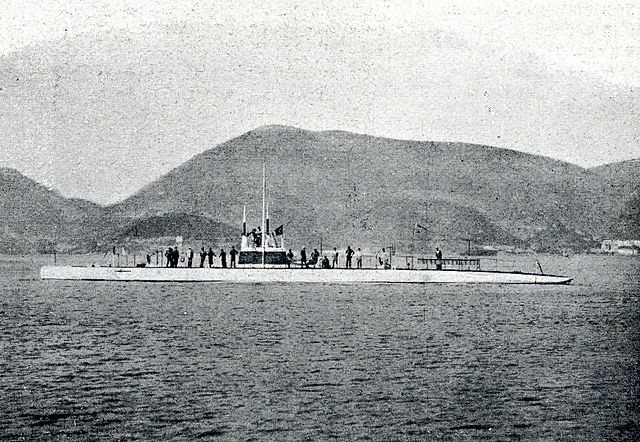
The Italian F-Class designed by the head of the Arsenale Reggio of Venice, Cesare Laurenti became world famous as the first double-hulled type. He later designed the “A” series as named in Spain, as a coastal submarine according to the February 1915 naval law. In fact they were the last three of a serie of 24 boats made for the Regia Marina, acquired by the Armada in mid-1916 and called also ‘Tipo Laurenti’.
Design
The A-class can reach submerged 45 m, better than many of its contemporaries (at leas for a coastal type). Each boat had two periscopes 90mm in diameter, for observation and attack. They were given a Gyroscopic compass and a Fessenden underwater acoustic signaling system active up to a range of 5 miles, plus a Forbes speed indicator. The hull was agile, given two groups of horizontal rudders. The aft group was fixed and underwater. The protruding keel’s hull was provided with balance keels and the thickness of the hull was variable in cross-section, up to 9-11 mm thick around the central section, kiosk and bow.
In the space between the two the double bottoms large rectangular openings could be closed. Therefore the lower central, bow and stern inter-hull spaces could be flooded as ballasts while the others were in free circulation. Fuel trim tanks were located between the two hulls also and the inner hull was crossed by transverse watertight bulkheads with communication doors. The three ships initially named F-22, F-23 and F-24 were transferred while in completion despite the Brazilian navy was also declared interested by the purchase and the deal amounted to 1,300,000 lira (1,822,000 pesetas) without torpedoes. In June 17, 1917, A1 became Narciso Monturiol and A2 Cosme García to honor Spanish submarine pioneer, A0 (the previous Holland boat), being named Isaac Peral.
Active service
By September 1, 1917 they set sail for Genoa, prepared for the trip to Spain, and arrived 4 days later at Tarragona accompanied by the Extremadura, which escorted them, and later Cartagena on April 14, where they were enlisted with Isaac Peral (A0) to form the A-class, first active Spanish Navy’s Submarine unit. The colors of the Spanish flag were painted on their kiosk, to avoid confusion and to signal neutrality. However these boats became outdated after the war and suffered frequent engines breakdowns. They were scrapped in the 1930s.
Notable events included August 22, 1919, King Alfonso XIII as guest of the A1. In December 21, 1920, the Submarine Instruction Division was formed with the A-class assisted by the Kanguro rescue ship and two torpedo boats. In June 1922, A3, Isaac Peral and B1 assisted troops at the Rock of Alhucemas, providing supplies and later reconnaissance and protecting the other two submarines. In 1923 the Mahón Submarines Division was created with A1 and A2. In 1927, Cosme García (A2) suffered a quick flooding of the torpedo room. The vessels however reached harbour and was salvaged with the help of two floating cranes. In 1931, she was discarded and scrapped, A3 followed by May 18, 1932, and A1 in September 1, 1934.
B class submarines (1922)

These 6 units were built by the Spanish Shipbuilding Society (SECN) in Cartagena, Spain (Bazán, Izar and Navantia). They were based on Class F-105 of the Holland Patent Electric Boat Company and were started in 1917 and licensed by the Electric Boat & Co, at a unit cost of 3 800 000 pesetas.
Their maximum immersion level was 60 m through a triple layer hull, the tough inner hull being circular in section to withstand high external pressures, the outer hull, lighter in construction, but arranged to receive high external pressure, calculated for a 30 m depth.
Design of the B-class submarines
Vertical control was installed aft and fully compensated, built in a special class cast steel with a total area of 4.94 m². Its diving apparatus consisted of two balanced rudders at the stern and two balanced rudders at the bow. The bow and stern diving wings were totally independent, maneuvered by different operators. There was a quick shift for electrical to manual mode and reverse.
They were fitted with a VS Boston Magnetic needle installed on the bridge and locked in a waterproof display case. They also had a Sperry Gyroscopic needle Mark II, Mod. 6, with a voltage regulator and three repeaters. The kiosk received two 74 and 86 cm Kelmorgen Optical signature periscopes, located in the control chamber, of the rotating type, operated by hand mechanism. Magnification was from 1.25 to 5, thanks to a Zeiss rangefinder for the launch of torpedoes. The periscopes could not work by night time given the low brightness.
One Acoustic probe was installed in 1929. Since 1931 they were given a Forbes slider in fuel tank No. 5 by S.E.C.N. One tote first one was installed in the stern storage chamber, on the gyroscopic needle. There also a small speed one in the control chamber between depth gauges. The high speed one was installed in the turret. The hull could be immobilized thanks to two 450 kg anchors at the end of a 16 m galvanized steel towing cable. To tie a buoy, the hull had two elbows of galvanized steel, 25 m long each as well as an electric winch and hand backup on the bow deck.
Propulsion consisted in two three-bladed manganese bronze blades, of a diameter of 622″, turning outward and rotating at 367 rpm at a top speed of 15 knots. Fuel consumption in 24 hours was 5232 kg at 320 rpm and 2016 kg at 250 rpm with a single engine, total fuel capacity was 51 129 l, reduced after the installation of the slide in 1931 to 50 186 L. In wartime, there was still the possibility of using ballast no. 2, to store 81 196 l of diesel. Capacity of the main lubrication oil tank was 5180 L, and return tank 1885 L. The shafts were driven by 2 diesel engines 4-stroke NELSECO for the surface and two electric motors with a battery of accumulators of 120 elements TUDOR and in backup two small electric motors procuring power in emergency for one hour. The disels were rated for 700 CV at 300 rpm and electric motors 210 CV + 420 CV (for one hour). This made the B-class quite fast underwater, as customary for Holland boats: 10.5 knots versus 16 on surface.
Their maximal depth was 60 m, normal operative depht 40 m. Autonomy was 2600 nm at top speed in surface, 4900 at 10,5 knots cruise speed, and 10,5 nm submerged or 90 at 4,5 knots.
They were armed with four tubes, two in the bow (with four torpedo Bliss-Leavitt in reserve plus two in the stern, and two in reserve. The Vickers 3-in gun was supplied with 200 rounds, including 120 high-explosive and 80 armor-piercing.
Career of the B-class submarines
These boats never received named but identification numbers painted on their kiosk. Their captains had the rank of ship’s Lieutnant until the beginning of the civil war.
Of the six class B, four were sen to the Naval Base of La Graña (Ferrol) and the other two remained at Cartagena. The B-1 and B-3 actively participated in the Rif war (Morocco), evacuating civilian personnel from the Vélez de la Gomera rock, and carrying water supply to the Rock of Alhucemas under enemy fire. The six submarines were active and in Republican hands during the Civil War, as well as the six Class C. By the end of the Civil War however four remained scuttled at Cartagena naval base. They were refloated, however their poor state banned any repair for two of them.
The B-1 collided in Alicante in 1937 with an English freighter. The bow superstructure was badly damaged, and the B-1 was left unrepaired until the end of the war, used as a target ship afterwards. B2 carried a Soviet officer using the pseudonym “Tomás Asensio” to discuss supplies with the Republicans. She ended half submerged in Cartagena. Refloated, she was used later in the Naval School of Mechanics in Ferrol. From 1948 she became a “floating power plant” until 1951 and sold for scrap but was lost during a storm while en route from Ferrol to Aviles for scrapping.
B-3 lso collided with a ship, Norwegian SS “Frank” in October 1937. She was repaired but relatively inactive and was scuttled in Cartagena at the end of the war. She was refloated and scrapped.
B-4 was bombed in Malaga in 1937, and discarded by the Republican Navy on March 15, 1937. She was also scuttled in Cartagena, refloated in 1939 and discarded again in 1941.
B-5 disappeared around April 15, 1937 near Estepona (unknown causes). B-6 was sunk on September 19, 1936 duelling on the surface with the armed tugboat Galicia, and later Ciriza and destroyer Velasco. The crew surrendered, and B-6 was later sank in the waters of Cape Peñas.
B-class Specification:
Displacement: 556/563 t surface, 716/718 t submerged
Dimensions: 64,18 m, 5,60 m wide (external) or 5,18 m (internal), and 3,55 m high
Armament: 4 x 450 mm TTs (2 bow, 2 stern) +6 torpedos Bliss Leavitt, 1 x 76,2 mm/45 gun, 200 rounds
Engine: 2 screws diesel 4-stroke NELSECO, 2 electric motors TUDOR, 2 extra motors for emergency
Top speed: 16 knots surfaced, 10.5 underwater
Immersion and range: 40-60 m, 4500 miles at 10.5 knots surfaced
Crew: 28-34
C class submarines (1928)
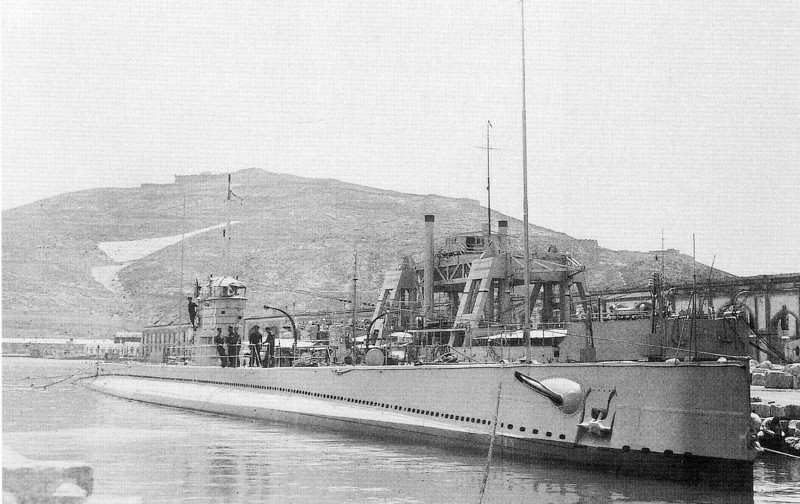
Submarine C3 and support ship Kanguro in Cartagena
Design of the C class
Spanish engineers pushed the envelope of the WW1-era patent from Electric boat, still active, on this serie of Holland design, leading to six boats launched at SECN (Sociedad Española de Construcciones Navales) in 1927-29 and completed in 1929-30. In short, they were faster on surface, had a better range, better underwater dive, and more powerful torpedoes with 533 mm tubes, to the cost of a slight decreased underwater speed, the trademark of a classic Holland design.
In 1923 the S.E.C.N. modified the old Holland 105F blueprints, larger and better armed, closer to the 1920 S-series built for the US Navy. In the hull shape, hydroplanes system, conning tower and other aspects many similarities were noted. However this was still an improvement of the earlier the B class. The major limitation was the number of batteries, identical to those of the B class. This severely limited the underwater speed and range. Numeral were no longer painted on the kiosk with the exception of the C-1 named Isaac Peral after the first was discarded.
The six units were identical in general appearance but had some some internal variations: Indeed all the boats lacked torpedo launch direction. They had however like the B-class underwater communication telephone and on the C-1 and C-2 Fessenden oscillators. Their maximum range was 2 miles. This was upgraded on C-4 and C-5 Electro-acoustic units with a range of 8 miles and Forbes type slide. Maximum immersion level was estimated 80 meters, and chances of a crushing dramatically augmented beyond. Unit cost was 13 186,000 pesetas.
Active service
These Class C submarines were quite active during the civil war. One carried officers of the Soviet Navy, but overall they did not achieve any kill.
If the C-3 was apparently torpedoed by U 34 with the loss of 37 men, there were also claims of an Italian submarine. C-5 was lost in unknown circumstances but Nationalist propaganda attempted to revendicate this as a kill by an Italian submarine, possibly even General Mola or General Sanjurjo. C-6, was scuttled and badly damaged before capture in Gijón. C-4 was lost in an accident in maneuvers, and was rammed at full speed by the destroyer Lepanto on June 27, 1946 cutting her in two.
The C3 in action
Among all these vessels, the career of C3 is a good example of a typical career of a Spanish submarine at that time. At the start of the Civil War on 18 July 1936, C-3 was in Cartagena harbour, under Lieutenant Rafael Viniegra González. She sailed with submarines B-6, C-1, C-4 and C-6 to the Gibraltar Strait. Capitán de Fragata Francisco Guimerá Bosch blockaded the strait and interdicted transport of rebel troops from North Africa, patrolling along the Andalusian coast.
On 20 July, the flotilla entered Málaga harbour as their crews decided to get rid of their executive officers, to the exception of Capitán de Corbeta Lara, jailed as supposed sympathizers of the rebels. The submarine fleet then departed Málaga for Tangier, escorting the oil tanker Ophir. On 27 July, the Málaga force was deployed off Cadiz to catch a Nationalist convoy. The latter prioved to be a decoy, the true one crossed in another point. C-2, and C-6 patroled in front of Ceuta harbour block entrance to the cruiser Almirante Cervera, coming from the Ferrol. In August, C-3 sailed for the Cantabric Sea with the C-6 and made another trip with C-4 and C-5. They all attempted to locate the battleship España and Almirante Cervera and escorted freighters.
C-3 was back in the Mediterranean in October, and on 12 December 1936, she was sailing on surface 4 nautical miles southeast of Málaga when capt. Alférez de Navío Antonio Arbona Pastor, was in the kiosk observing the sea when at 14:19 a massive explosion ripped her starboard bow apart. The C-3 sank quite quickly. This explosion was observed by the coastguard vessel Xauen two miles away and two fishing boats. The only survivors were the pilot, García Viñas in the kiosk as well as sailors Isidoro de la Orden Ibáñez and Asensio Lidón Jiménez, dumping trash and garbage on the deck when it happened. The Axis soon revendicated the kill, U-34 (Kapitänleutnant Harald Grosse), for Operation Ursula for the Germans, while the Republicans claimed it was an internal explosion. A seach began the next days, but only a large oil slick was found.
C-class Specification:
Displacement: 925 t surface, 1144 t submerged
Dimensions: 76,3 m, 8,3 m wide (external) or 5,7 m (internal)
Armament: 6 x 533 mm TTs (4 bow, 2 stern) +4 torpedos Bliss Leavitt, 1 x 76,2 mm/45 gun, 200 rounds
Engine: 2 screws diesel 4-stroke Vickers, 2 electric motors TUDOR 1000 hp
Top speed: 16.5 knots surfaced, 8.5 underwater
Immersion and range: 80 m, 6800 miles at 10 knots surfaced
Crew: 40
General Mola class submarines (1937)
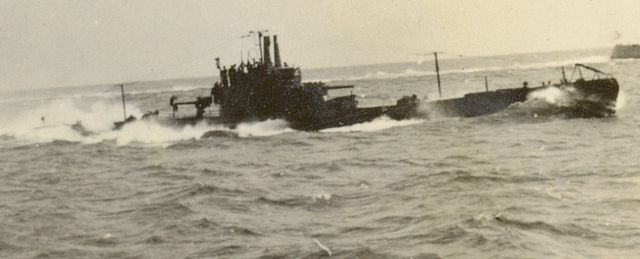
The General Mola and Sanjurjo, two prominent figures of the Nationalists after Franco, were formed Italian Archimedes class submarines transferred to Spain in 1937. Back in 1931 four submarines were laid down in Italy under the names of Archimede, Torricelli, Ferraris and Galilei, making the Archimede class. They retained the hull lines of their predecessors but had more autonomy and greater armament than the Settembrini Class. They were good walkers in surface, stable, fast, with excellent handling and sturdy enough to dive to 90 m with safety.
On September 11, 1936, a meeting was held in Cáceres between the heads of the Nationalist Navy and of the (future) Axis. By decision the latter were to send submarines in aid of the nationalist fleet which did not had any. They would act operationally under the overall naval command of the rebels. On April 29, 1937 Italian submarines were examined by Admiral Somigli, head of staff of the Regia Marina, and after premises were accepted, Archimede and Torricelli were picked up.
After a brief period of maintenance and short overhaul, both submarines left Gaeta on April 17, 1937, heading to the Nationalist-held Balearic Islands. They had a reduced operating crew with Italian sailors and some Spaniards which were already sent to train in Italy.
On the 19th of April, they drop anchors in a small bay on the island of Cabrera. There, they were met by the two armed vessels which sailed previously from Cádiz, with the Spanish crew. It was made up of volunteers from other units of the Navy. The two submarines were delivered after disembarking Italian personnel. They started a period of training, and were initially named C-3 and C-5 in commission, to confuse the Republicans about their supposed origin, sunken C-class boats recovered, and hide their true origin. Later in August they were renamed General Mola and General Sanjurjo.
These submarines were soon joined by four more, the two remainder of the class, Ferraris and Galilei for commonality, and the Iride and Onice of the coastal Perla class, receiving at first the false names of General Mola 2º and General Sanjurjo 2º and later González López and Aguilar Tablada. For four months they increase confusion in Republican naval intelligence, on purpose. They all operated from Sóller naval base in Mallorca against republican and neutral merchant traffic bound to the Mediterranean coast of Spain. They operated in coordination with auxiliary cruisers, the Cruiser Division, the legion and axis aviation, as well as other Italian submarines Italians. They also performed surveillance and espionage missions. One was at some point believed to have sank the submarine C3.

General Sanjurjo’s first captain was Pablo Suances Jaúdenes. In May 13, 1937, together with General Mola she sailed towards the Sicilian canal, carrying out exploration missions in the Spartivento canal. Both torpedoed and sank the City of Barcelona, a 3946-ton vessel off Tordera cape, near Malgrat. The ship was carrying volunteers from the International Brigades. They also torpedoed the motorboat Granada, returning to Sóller. They made a second patrol from June 29 to the Catalan coast. There, they surprised the oil tanker Campero, later damaged by artillery fire, but she survived and was saved by the intervention of Republican aviation. On July 26 both submarines sank near Alicante the Cabo de Palos of 6342 tons. On August 21 they made their third raid, to locate a seaplane.
On August 30, Mola attacked the Ciutat de Reus with artillery (shortage of torpedoes) about 20 miles off Sète, France, but the ship fled in French waters. In September both submarines made another patrol and in mid-October moved to Taranto for refit, until November 25.
Once the war was over, her stern artillery pieces was suppressed. On February 7, 1943, Gen. Sanjurjo was attempting a rescue mission when she was attacked by British submarine HMS Torbay, 55 miles east of Cartagena. She had been indeed mistaken for an Italian submarine. The Armada from then ordered the kiosk of both subs to be painted white as a result of the incident.
Sanjurjo made her last trip to Alicante on April 27 and discarded on July 14, 1959.
G class submarines (1942)
On June 8, 1940, U 573, a VIIC type U-Boat was delivered by Blohm & Voss, Hamburg to the Kriegsmarine on June 5, 1941. She started her career under Kapitänleutnant Heinrich Heinsohn. He was assigned to the 3rd Fleet in Kiel and by September, La Pallice (France) until January 1942.
On December 21, the U 573 crossed the Strait of Gibraltar for the 29th Fleet based in La Spezia. On her four patrol she sank the Norwegian Hellen of 5289 t. On April 29, 1942, she was northwest off Algiers, when detected and attacked by a Lockheed Hudson of the 233 Squadron RAF. She was near-missed by 325-pound depth charges, taking serious damage. Too damaged to join La Spezia she turned instead to the nearest harbour, Cartagena, reached on May, 2 using only the electric port engine, the only left working.
The Spanish government granted three months for repairs, despite Allied protests but this proved impossible. According to international laws, the submarine was to be requisitioned, and documentation and some part of the equipment destroyed and the crew sent back to Germany. However it was decided in Germany to sale it instead to the Spanish Navy for 1,500,000 reichsmarks. She was received on August 2, registered on the Official Ship List of the Navy as G7. The crew and their commander were repatriated in March 1943.
The G7 was repaired from December 30, 1942, waiting for German information and technical assistance. Eventually the process really started in August 1943. This would go on until until 1947. G7 made her new sea trials, but was outdated, although the best Spanish submarine in service. The D class were already of an older design, the VIIA.
Attempts were made to modernize her, and eventually Bazán Yard started work in 1951 to develop a snorkel to be used on the D-class as well and General Mola Class. However this never happened. Eventually, G7 typical bow trimmer was suppressed and a 20 mm aft AA gun was kept until the sixties.
Until 1959 and the transfer of S-31 Admiral García de los Reyes, under 1953 MDAP Agreements the G7 was the best Spanish submarine despite its lack of sonar, radar and snorkel. In 1961 she was renamed S-01 and was painted in black overall and later discarded in May 2, 1970. She was scrapped, despite efforts for her conservation. Only her deck gun, 88 mm/45 Rheinmetall Borsig is exposed in the Naval Museum of Cartagena.
D class submarines (1944)

Reconstitution of the D-3 as completed in 1954
The State-held former Vickers delegation shipyards of Cartagena, Ferrol and Carraca in Cádiz received for the Armada a project of oceanic submarine of 1,000, 20 knots (surface). The SECN entrusted naval engineer and director Áureo Fernández Ávila (Ferrol), which tried to achieve an improved “C” type. This however proved quite difficult.
Navy Minister José Giral promulgated the naval Law of August 30, 1932, with an order in November 22, 1932, to built the class D. The first keel was laid down on September 23, 1933. This was a splendid subersible for its time, displacing 1,000 tons and with a 120 mm cannon, six 533 mm tubes, 9.5 knots underwater and a 80 meters depth. However soon, despite the contracted three years for completion, work progressed very slowly.
Twenty years in the making, since the keel was laid down
Meanwhile in Cartagena were started the D-2 and D-3, laid down on November 19, 1934 and December 11 1934. Construction called for the classic riveting system abandoned elsewhere, illustrating the technological gap of the Spanish industry. Adding to the complexity of the project, insufficient financing, and a long assimilation of the licence to built the two powerful 2500hp “Sulzer” diesels by SECN also took their toll on the project.
Construction dragged on for two more years, until the civil war broke out. Work on D1 stopped abruptly, and on the D-2 and D-3 as well. They were barely started due to a shortage of of materials. They were left abandoned, rusting in their slipways until 1939.
World War II broke out shortly after and at the end of 1939, decision was to be made whether replacing them with new modern German or Italian types or complete them with Axis assistance, which was the choice made in February 1940. Their design was modified, with the replacement of British-made equipment by German and Italian hardware. However, delivery took time.
Since the 1908 contract signed with the State Naval Construction Society had expired, the State Military Naval Construction Council was created, headed by naval engineer Áureo Fernández Ávila to andle this redrawn of the design, modifications and completion.
Defects

One of the very rare photos of the D2 (later S21) in 1952. Source
However with a country and industry ruined, lack of materials of all kinds and restrictions, little could be done. Not only construction was very slow, but the boats accumulated defects, together with a cost which doubled, from 17,400,000 to 32,500,000 pesetas.
On May 11, 1944, D-1 at last was launched after ten years, but delivery would only take in March 1947. Indeed the axis being defeated no support could be expected and new sources for parts must be secured. Trials showed the D-class experienced negative transverse stability when surfacing, raising the keel almost vertical.
The low quality steel used made her displacement rose to 1,095 tons and dive tests off Mazarrón showed a crushing tolerance down to 50 meters. At the end of 1944 D-2 was launched but not operational until May 1951. D-3 was launched in 1952, commissioned in 1954, twenty years since her keel was laid down.
All three could launch standard WW2 German torpedoes G7a and G7e which were in stock. The “D” accumulated so many defects they were relegated to training missions. They were procured however a deck-mounted 88 mm Krupp cannon instead of the intended Vickers-Armstrong 12 cm gun and the two AA MGs. However reports of defects accumulated: ‘Vicious’ ballast system causing poor stability, numerous other hull defects, bad ventilation and habitability. On top of this, the Spanish Sulzer diesels copies produced a strong vibration which curtailed dramatically their reliability.
Modernization attempts
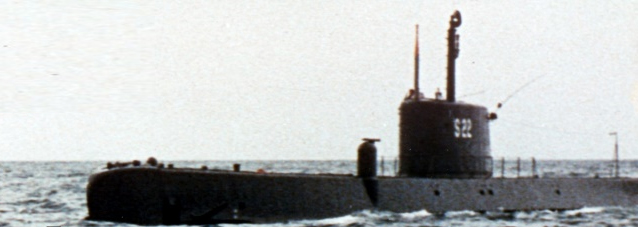
S-22 in the 1960s after modernization. The hull is streamlined, a new conning tower was built, modern equipments for the sonar, radar and sensors. S-22 and 23 were discarded in 1971. Never modernized however, the training submarine S-11 (former D-1) stayed in her original U-Boat style until 1965. SOURCE
In 1956 with the help of the US Navy, it was decided to modernize the D-2 and D-3. On October 15, 1960, D-3 went to drydock in Cartagena followed later by D-2, revised completely by Spanish and North American engineers. Drafted modifications were made, to go from surface training ships to fully capable attack submarines. Bazán went as far as disassembling the outer hull, deck and conning tower, leaving only the inner hull intact. Work affected the water lines, more hydrodynamic, a new smaller support for the gun was mounted and 88 mm gun deleted as well as the the pair of aft launching tubes.
Electronic sensors of US manufacture were integrated, SJ-1 radar, WFA-16 sonar, however no Snorkel was included. The power plant was not altered but the revised hull allowed fater speeds, down to 18 knots in surface and 10 in immersion. The crew rose to 74 men. On June 15, 1961 the D-2 and D-3 were renamed S-21 and S-22, and work ended on December 15, 1962 for S-22 and April 15, 1963 for S-21. Despite of this, both proved still defective, noisy and dangerous due to their poor transversal stability. Both were retired ten years after, in 1971.

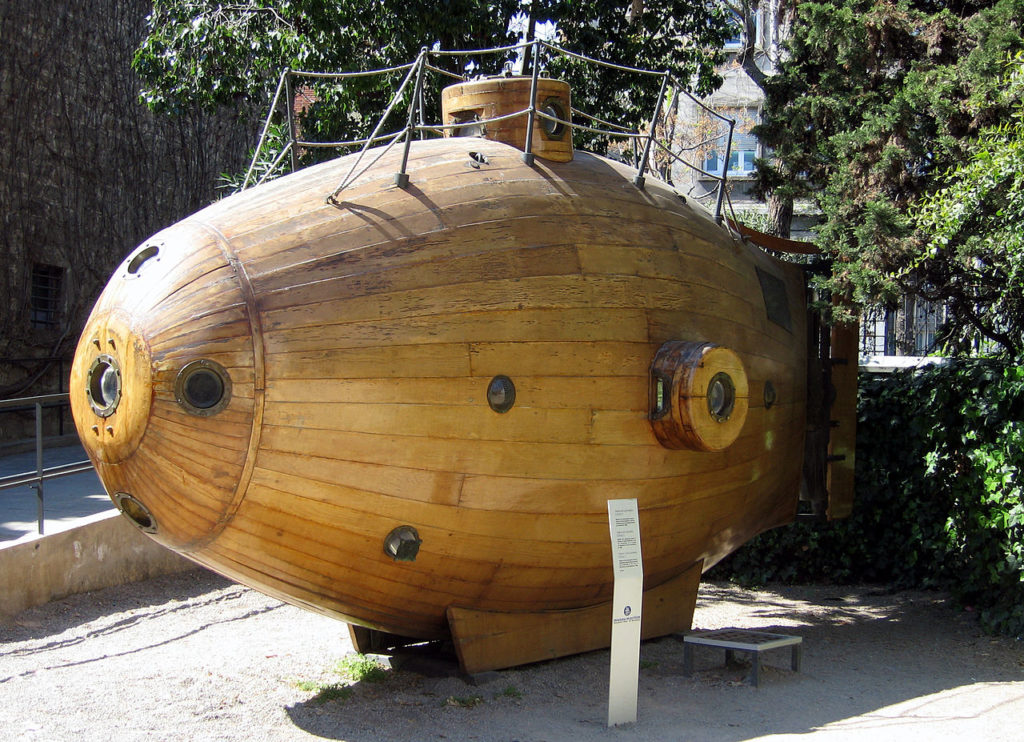
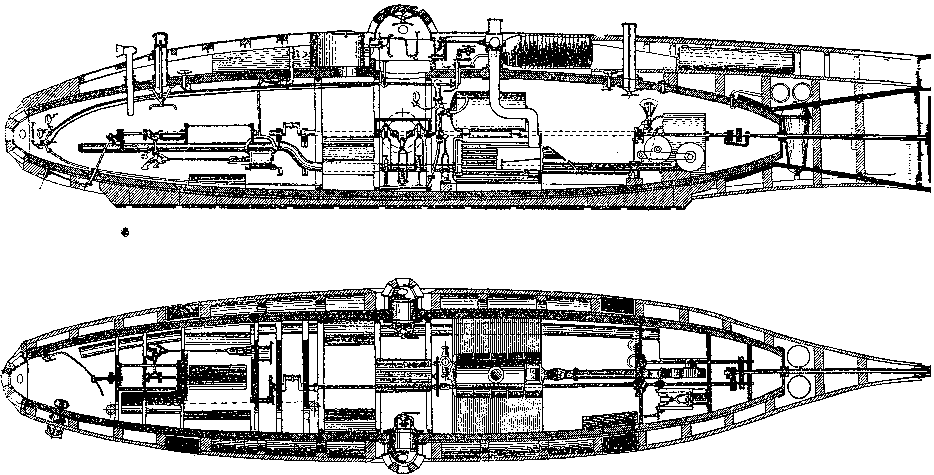
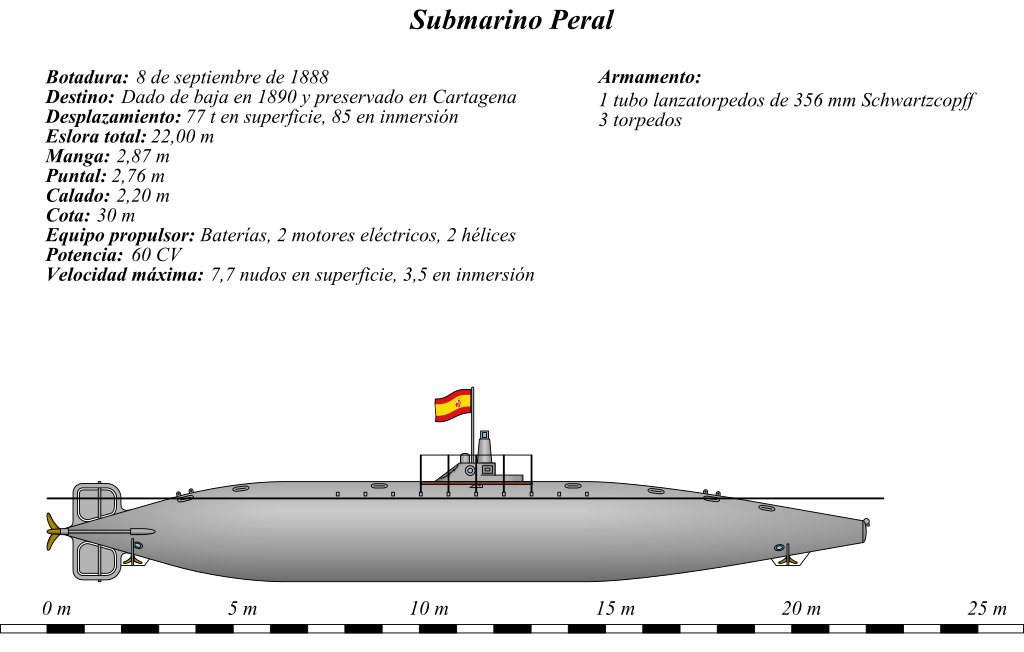
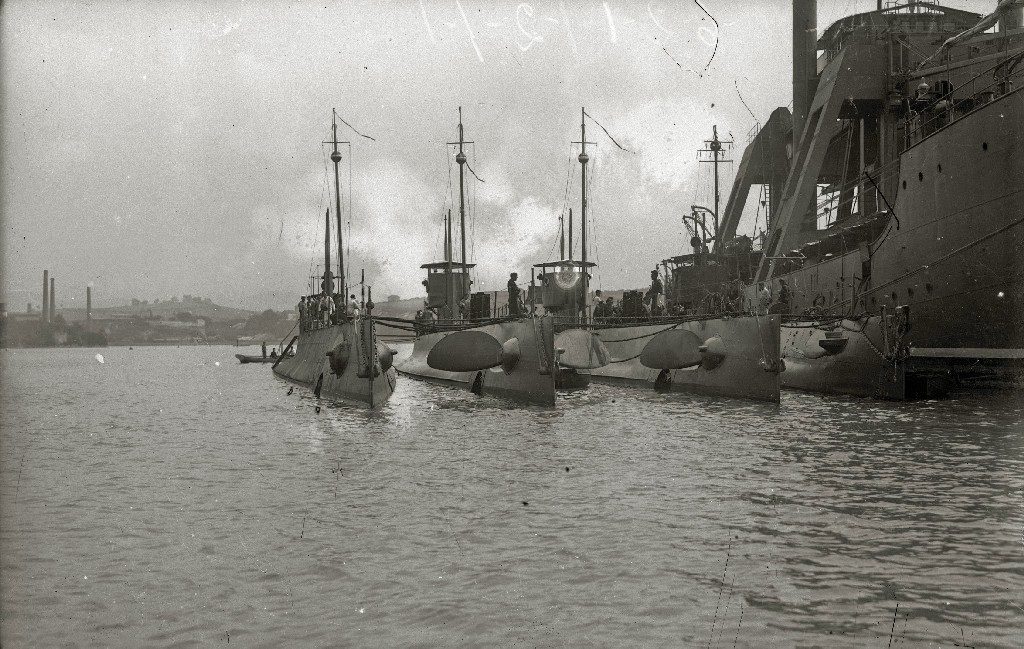
 Latest Facebook Entry -
Latest Facebook Entry -  X(Tweeter) Naval Encyclopedia's deck archive
X(Tweeter) Naval Encyclopedia's deck archive Instagram (@navalencyc)
Instagram (@navalencyc)





 French Navy
French Navy Royal Navy
Royal Navy Russian Navy
Russian Navy Armada Espanola
Armada Espanola Austrian Navy
Austrian Navy K.u.K. Kriegsmarine
K.u.K. Kriegsmarine Dansk Marine
Dansk Marine Nautiko Hellenon
Nautiko Hellenon Koninklije Marine 1870
Koninklije Marine 1870 Marinha do Brasil
Marinha do Brasil Osmanlı Donanması
Osmanlı Donanması Marina Do Peru
Marina Do Peru Marinha do Portugal
Marinha do Portugal Regia Marina 1870
Regia Marina 1870 Nihhon Kaigun 1870
Nihhon Kaigun 1870 Preußische Marine 1870
Preußische Marine 1870 Russkiy Flot 1870
Russkiy Flot 1870 Svenska marinen
Svenska marinen Søværnet
Søværnet Union Navy
Union Navy Confederate Navy
Confederate Navy Armada de Argentina
Armada de Argentina Imperial Chinese Navy
Imperial Chinese Navy Marinha do Portugal
Marinha do Portugal Mexico
Mexico Kaiserliche Marine
Kaiserliche Marine 1898 US Navy
1898 US Navy Sovietskiy Flot
Sovietskiy Flot Royal Canadian Navy
Royal Canadian Navy Royal Australian Navy
Royal Australian Navy RNZN Fleet
RNZN Fleet Chinese Navy 1937
Chinese Navy 1937 Kriegsmarine
Kriegsmarine Chilean Navy
Chilean Navy Danish Navy
Danish Navy Finnish Navy
Finnish Navy Hellenic Navy
Hellenic Navy Polish Navy
Polish Navy Romanian Navy
Romanian Navy Turkish Navy
Turkish Navy Royal Yugoslav Navy
Royal Yugoslav Navy Royal Thai Navy
Royal Thai Navy Minor Navies
Minor Navies Albania
Albania Austria
Austria Belgium
Belgium Columbia
Columbia Costa Rica
Costa Rica Cuba
Cuba Czechoslovakia
Czechoslovakia Dominican Republic
Dominican Republic Haiti
Haiti Hungary
Hungary Honduras
Honduras Estonia
Estonia Iceland
Iceland Eire
Eire Equador
Equador Iran
Iran Iraq
Iraq Latvia
Latvia Liberia
Liberia Lithuania
Lithuania Mandchukuo
Mandchukuo Morocco
Morocco Nicaragua
Nicaragua Persia
Persia San Salvador
San Salvador Sarawak
Sarawak Uruguay
Uruguay Venezuela
Venezuela Zanzibar
Zanzibar Warsaw Pact Navies
Warsaw Pact Navies Bulgaria
Bulgaria Hungary
Hungary

 Bundesmarine
Bundesmarine Dutch Navy
Dutch Navy Hellenic Navy
Hellenic Navy Marina Militare
Marina Militare Yugoslav Navy
Yugoslav Navy Chinese Navy
Chinese Navy Indian Navy
Indian Navy Indonesian Navy
Indonesian Navy JMSDF
JMSDF North Korean Navy
North Korean Navy Pakistani Navy
Pakistani Navy Philippines Navy
Philippines Navy ROKN
ROKN Rep. of Singapore Navy
Rep. of Singapore Navy Taiwanese Navy
Taiwanese Navy IDF Navy
IDF Navy Saudi Navy
Saudi Navy Royal New Zealand Navy
Royal New Zealand Navy Egyptian Navy
Egyptian Navy South African Navy
South African Navy






























 Ukrainian Navy
Ukrainian Navy dbodesign
dbodesign
Thank you for this post. My late father in law served onboard General Mola about 1954. His stories about the crumbling, ancient subs were my favourite.
Thanks Jorge !
Feel free to leave some of these impressions here in the comments.
Cheers,
David B
This perhaps could be of your interest:
https://www.lavozdeasturias.es/noticia/asturias/2020/11/12/odisea-submarino-republicano-sobrevivio-44-horas-angustiosas-bajo-mar/00031605178533897446205.htm
Greetings
Thanks Carlos, interesting story indeed !